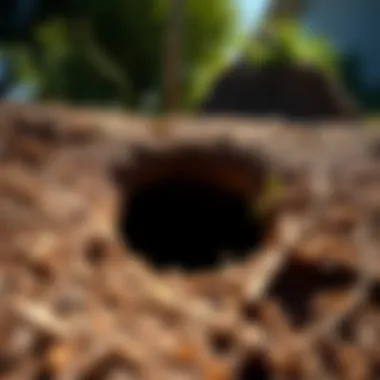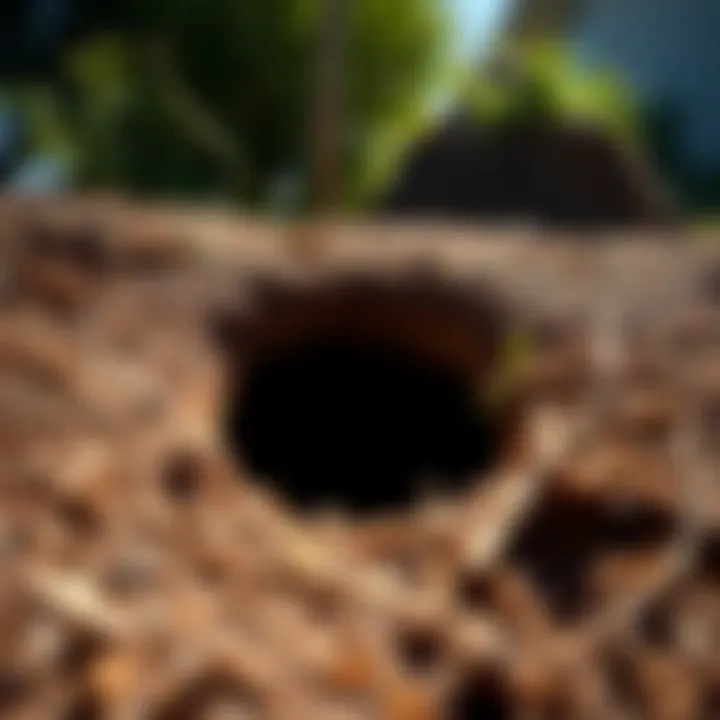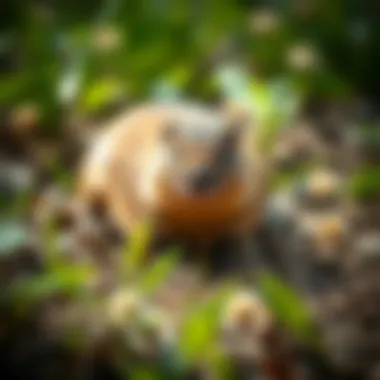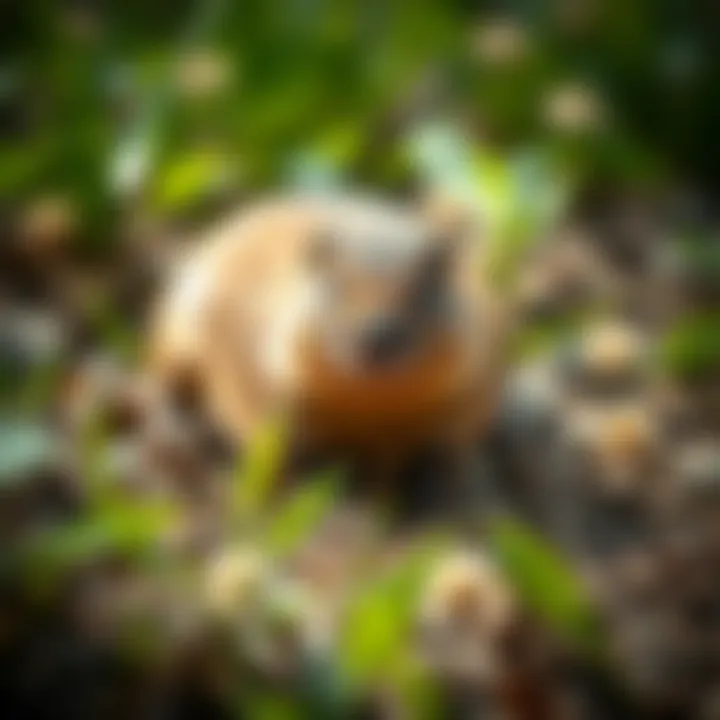Effective Methods for Managing Gophers in Your Yard


Intro
Dealing with gophers can feel like a never-ending tug-of-war, especially for homeowners who take pride in their gardens and lawns. These small, burrowing rodents, known for their distinctive mounds of soil, can wreak havoc on beautiful yards, devouring roots and disrupting the delicate balance of your landscaping. Understanding how to effectively manage gopher populations is essential for preserving your outdoor space.
This article delves deeply into managing gophers, offering a blend of knowledge on their biology, behavior, and the effective strategies you can implement. We will touch upon their distinguishing features, the lifecycle that fuels their population growth, and most importantly, a variety of control methods. Whether you prefer preventative techniques or a proactive approach, this guide aims to provide essential insights, ensuring your yard remains a sanctuary for plants and not a buffet for gophers.
Understanding Gopher Behavior
Understanding the behavior of gophers is fundamental for anyone trying to maintain a healthy yard or garden. By grasping their habits and lifestyle, homeowners can preemptively manage potential infestations. It’s not just about dealing with a few pesky rodents; it’s about preserving the beauty and integrity of your landscape. Knowing what makes these creatures tick can make a significant difference in both prevention and control efforts.
Biology of Gophers
Gophers, members of the family Geomyidae, are small rodents known for their burrowing habits. They typically range from about 6 to 12 inches long and have stout bodies, short legs, and strong claws, which are ideal for digging. One notable feature is their cheek pouches, which allow them to transport food back to their underground homes. More than just cute, their underground lifestyle has led to a unique set of survival adaptations. For instance, their fur is velvety and can be thick enough to keep them warm from the cold earth.
Gophers live in complex tunnel systems that can extend for hundreds of feet. These tunnels serve various purposes—shelter from predators, storage for food, and pathways for mating. This intricate digging can result in some serious disturbances above ground, especially if a colony of gophers takes up residence in your yard.
Diet and Feeding Habits
Gophers are herbivores, primarily feeding on roots, tubers, and other plant parts. Their preference lies in tender plant shoots and roots, making newly planted gardens a favorite feast.
Many homeowners have likely noticed the aftermath of gopher activity: ragged holes in their lawns or the sudden wilting of garden plants. This is largely because gophers do not just nibble on the surface; they tend to make a meal of the entire root system leading to the quick downfall of whatever unsuspecting plant they target. Observing gopher feeding habits is key to understanding their impact on gardens and landscapes.
Reproductive Patterns
When it comes to reproduction, gophers are quite remarkable and surprisingly productive. A single female can produce two to four litters a year, with about three to five young in each litter. What’s more, these young gophers are mature enough to reproduce in just a matter of months. This means that an unchecked gopher population can explode swiftly, turning a little annoyance into a significant problem in no time.
The breeding season generally peaks in the spring and can vary slightly depending on climate. As they breed throughout the year, it’s beneficial to keep an eye out for these patterns, especially before planting seasons. Keeping turf, gardens, and flowerbeds well-maintained might also deter gophers from seeing your yard as a prime breeding ground.
Understanding gopher behavior is the first step in creating effective control strategies. Knowledge is power, and that’s especially true when it comes to managing these persistent rodents.
Identifying Gopher Activity
Recognizing gopher activity in your yard is crucial for effective management of these burrowing mammals. Early identification can save your plants and turf from possible damage, allowing you to take proactive measures before their populations grow. Familiarity with the signs of infestation means you can avoid costly repairs or replanting, and it helps in implementing the right control methods swiftly. The key elements to look for include physical signs of infestation, soil disturbances, and plant health indicators.
Physical Signs of Infestation
Gophers are notorious for creating distinct marks in the landscape. One of the most noticeable signs is the presence of underground tunnels and mounds of soil. These mounds appear where gophers have pushed up dirt as they excavate. Usually circular or crescent in shape, the size of these mounds can vary. If you've got mounds appearing in your yard, it’s like a big sign flashing that gophers are around.
Key Signs to look out for:
- Small mounds of dirt, typically about the size of a basketball.
- Freshly turned soil, indicating recent tunneling activity.
- Low, scraggly patches of grass or disturbed garden areas.
Keep an eye out, especially after heavy rains when gopher activity may be more pronounced due to the loosened soil.
Soil Mounds and Tunnels
The gopher tunnel system often resembles a complex maze just below the surface. These tunnels can extend for several feet, allowing gophers to traverse large areas without coming up for air. The mounds of soil you see are just the tip of the iceberg, a visible marker of the activity taking place beneath your feet. When you spot these mounds, take note of their condition—fresh ones signify active gopher populations, while older, eroded mounds might be an indicator of less current activity.
Mounds often present in straight lines or circular patterns can help confirm where the gophers are running amok. It might feel like a gopher highway if you notice multiple mounds in close proximity.
Plant Damage Indicators
Another critical element to assess is the health of your garden and yard. Gophers are herbivores and enjoy a varied diet which often includes roots, bulbs, and herbaceous plants. If you notice:
- Wilting plants that appear suddenly healthy one day and droopy the next.
- Missing bulbs or roots from newly planted flowers or vegetables.
- Unevenly eaten foliage where gophers might snip plants at the base.
These signs may suggest that gophers are having a feast underneath, damaging everything you’ve worked hard to cultivate. By closely observing the state of your plants and noticing whether they have diminished or unfurl development patterns, it becomes apparent when gopher populations begin to interfere with your gardening efforts.


Preventive Measures
When it comes to managing gopher populations, being proactive can save a lot of headaches down the line. Preventive measures provide a solid foundation in your strategy, limiting the chances of infestation before it becomes a larger issue. The very essence of these measures hinges on understanding gophers’ habits and behaviors. It’s almost like knowing your enemy—if you can outsmart them ahead of time, you can keep your yard safe and sound.
Landscaping Strategies
Implementing thoughtful landscaping practices can have a powerful impact on keeping gophers at bay. One elementary yet underappreciated strategy is to create a diverse and dense plant layout. Gophers prefer certain types of vegetation, so mixing in harder-to-reach plants or those that gophers tend to avoid can be effective.
- Include native plants: These plants are often better suited for your local ecosystem, reducing the need for maintenance and keeping gopher food sources to a minimum.
- Mulching and ground cover: Using mulch can be beneficial because it creates a barrier and makes it difficult for gophers to dig.
- Strategically placed rocks or gravel: Incorporating rocks around the garden can deter digging. Gophers do not like to dig through these materials.
By strategically planning your garden layout and planting choices, you can create an environment that’s less inviting to gophers.
Use of Barriers
Physical barriers are another proactive approach that homeowners can consider. These barriers not only prevent gophers from entering your garden but also protect specific plants. A popular method is to install wire mesh around the perimeter of garden beds or around individual trees.
- Wire mesh: Use galvanized hardware cloth with holes no larger than an inch to encase the roots of plants. Bury the mesh at least a foot deep to ensure gophers can’t burrow underneath it.
- Underground fencing: Similar to wire mesh, underground fencing can be placed a foot deep around the entire garden.
While creating these barriers requires a bit of effort upfront, the long-term results can be quite rewarding. It’s all about thinking ahead and defending your garden like a castle.
Plant Choice Considerations
The plants you choose can play a significant role in preventing gopher infestations. Gophers are more inclined to feed on certain species, so selecting plants that are less palatable to them is a key defensive strategy.
- Planting gopher-resistant species: Some plants are known to be disliked by gophers, such as lavender, sage, and certain herbs. These can add beauty and fragrance to your garden while acting as a deterrent.
- Avoid plants that gophers love: Vegetables like carrots and potatoes are favorites. Consider substituting these with more resistant options like tomatoes or squash, which are less likely to attract gophers.
Choosing the right plants can help you fortify your yard, making it less of a target for gopher activity.
"An ounce of prevention is worth a pound of cure."
In summary, employing preventive measures against gophers consists of strategic landscaping, implementing barriers, and making informed plant choices. These approaches not only contribute to a healthier yard but also spare you the hassle of dealing with pest control later on. Taking the time to put these preventive strategies in place can be a game-changer for your gardening success.
For further reading on best practices, check out resources like Wikipedia and National Pesticide Information Retrieval System.
By staying vigilant and being proactive, you can enjoy a gopher-free yard and help maintain a balanced ecosystem.
Trapping Techniques
When it comes to managing gopher populations in your yard, trapping stands as one of the most effective and direct methods. This tackles the problem head-on, allowing homeowners to control gopher numbers without relying heavily on chemicals or other interventions. Understanding the importance of trapping techniques is vital for anyone grappling with these burrowing nuisances. They not only help in curbing damage to the lawn or garden but also provide insights into gopher behavior.
Types of Traps
In the world of gopher control, traps come in different styles, each with its unique mechanism and purpose. Here’s a glance at common types:
- Box Traps: These are humane traps designed to capture gophers alive. They use a bait system to lure the animal inside, after which the door closes, securing the gopher without harming it.
- Tunnel Traps: As the name implies, these traps are placed directly in the gopher’s tunnel. They typically work through a spring mechanism that triggers upon the gopher’s movement, capturing it instantly.
- Self-Resetting Traps: Perfect for those looking to trap multiple gophers over time, these traps automatically reset after a capture, making them a convenient option for ongoing infestations.
Each type has its pros and cons, so it's essential to choose one that fits your specific needs and preferences, especially considering ethical concerns.
Proper Trap Placement
Realizing success with traps isn’t solely about the type; placement is equally crucial. Here are some pointers to ensure your traps are set where they can be most effective:
- Identify Active Tunnels: Before setting any traps, observe your yard for signs of recent gopher activity. Look for mounds, fresh soil, or disturbances that indicate active tunnels.
- Choose the Right Location: Set traps in the center of the most active tunnels. You can test this by gently probing the soil to see where the tunnel feels solid versus soft. Placing the trap here maximizes the chances of a catch.
- Cover the Trap: Camouflaging your trap can increase its effectiveness. Use soil to cover the trap lightly. This makes it more appealing for the gopher to enter, as they usually avoid exposed items in their environment.
Best Practices for Successful Trapping
To improve your chances of success when trapping gophers, consider the following best practices:


- Use Proper Bait: Gophers are attracted to certain foods. Their diet tends to lean towards roots and tubers, so using bait like peanut butter on carrots or pieces of a potato can lure them effectively.
- Check Traps Regularly: If you set traps, monitor them daily. Leaving them unchecked for extended periods can lead to unnecessary suffering for humane traps or missed opportunities with lethal traps.
- Keep It Clean: When handling traps, ensure they are free from human scent. Gophers have a keen sense of smell, and any foreign odors can deter them from approaching.
By combining the right types of traps with strategic placement and adhering to these best practices, homeowners can effectively mitigate gopher issues in their gardens.
Engaging in trapping not only helps maintain the integrity of your yard but also serves as an engaging challenge to solve the puzzle of gopher management. For those who prefer a more hands-on approach to dealing with these critters, mastering trapping techniques offers a direct and satisfying route to resolution.
Chemical Controls
When it comes to managing gopher populations in your yard, chemical controls can become an essential part of your toolkit. These methods can provide an effective solution when used appropriately. Understanding how to apply these controls responsibly is crucial not only to ensure success in pest management but also to minimize potential harm to the surrounding environment.
Types of Chemical Repellents
There are various types of chemical repellents available on the market that target gopher behavior specifically. Some of the more common types include:
- Castor oil: This is a natural product that many homeowners have found effective. It can irritate gophers and deter them from burrowing.
- Synthetic repellents: These are generally more potent and can include formulations that interrupt tunneling behavior. They tend to be marketed specifically towards rodent control, and it's essential to follow the manufacturer’s instructions closely.
- Granular bait products: These often combine poisons with attractants. While they can be effective for quick results, they carry risks for pets and local wildlife if not used carefully.
It’s wise to assess your yard's specific needs and possibly consult a garden professional to choose the best option tailored for your situation.
Application Techniques
Applying chemical controls should be done with precision and care. Here are some best practices:
- Read the Directions: Always start by understanding the manufacturer's guidelines. Misapplication can lead to failure of the product or unintended harm.
- Target Areas: Focus on areas with evident gopher activity, like the edges of flower beds or vegetable gardens.
- Timing: Early morning or late afternoon are generally the best times for application, as gophers are most active during these periods.
- Use Bait Stations: Setting up bait stations can help to Protect other animals in the environment, allowing only gophers to access the poisons.
- Monitor Results: After application, keep an eye on the affected areas to evaluate effectiveness. If you haven’t seen any changes after a set time, it might be time to consider alternate methods.
Environmental Considerations
While chemical controls can be effective, it’s vital to consider their impact on the environment. Here are a few points to bear in mind:
- Non-target Species: Chemicals may affect beneficial insects and other wildlife. If your yard has pollinators, you need to be especially careful.
- Soil Health: Some chemicals can harm soil microorganisms vital for maintaining healthy plant life. It’s essential to use products that pose minimal risk to your garden's ecosystem.
- Pet Safety: If you have pets, ensure any chemical products you use are safe around them. Always store toxic substances in areas that are out of reach of animals and children.
- Local Regulations: Be aware of any regulations in your area regarding chemical use for pest control. For instance, some areas might have guidelines on which chemicals can or cannot be used.
Consider consulting your local extension office or pest management professionals if you have doubts about the products you're using.
For additional guidance, visit USDA.gov or check out the informative sections on eXtension.org for various pest management tips.
Humane Control Options
In managing gopher populations, humane control options stand as a significant pillar in responsible pest management. Many homeowners find themselves in a quandary when dealing with these burrowing critters, especially between the need to protect their landscaped yards and the ethical considerations of dealing with wildlife. Selecting humane methods reflects not only a commitment to ecological balance but also civil responsibility towards the animals that coexist in our environments. Employing these strategies can be particularly beneficial in enhancing both community relations and personal satisfaction.
Relocation Strategies
Relocation is one way to address a gopher issue without resorting to lethal measures. This approach involves trapping gophers and then moving them to an area far from your property. Here are a few considerations:
- Trapping: Use humane traps that don’t harm the animal. Ensure that the trap is large enough to accommodate an adult gopher comfortably.
- Timing and Season: It's best to trap during spring or early summer when gopher populations are generally more active.
- Site Selection for Release: Choose release locations that are at least a mile away. Relocation to close areas may result in the gophers returning to your yard.
Make sure to check your local wildlife regulations regarding trapping and relocation. It's needed to put nature first and do this legally and ethically.
Natural Deterrents
Sometimes, using natural deterrents can also be effective. Various substances and plants can discourage gophers from tunneling into your yard. Consider the following:
- Plants that Repel: Certain plants like daffodils and marigolds are known to deter gophers. These plants exude natural toxins that gophers tend to avoid.
- Smell and Taste Aversion: Garlic, castor oil, and other strong-smelling plants may repel gophers. You can also create a spray from these ingredients to apply around burrows.
- Nematodes and Other Predators: Beneficial nematodes can attack gopher larvae. Encouraging natural predators, like owls and hawks, to visit your yard can also help keep gopher numbers in check.
Utilizing these methods not only keeps gophers at bay but fits well within the ecosystem, allowing for a balanced relationship with wildlife.
Community-Based Solutions
Addressing gopher issues on a community level can amplify the effectiveness of humane control methods. Here are a few ideas:


- Community Awareness Programs: Organize your neighborhood around a common goal by raising awareness about humane gopher control. Sharing knowledge can help others understand the importance of humane treatment and effective solutions.
- Collaborative Trapping Initiatives: Engage with local neighbors to conduct trapping campaigns. This method ensures the efforts are concentrated and can lead to more significant results as more properties work together.
- Share Resources: Team up to buy traps and deterrents, or share your experiences and strategies via community forums or local social media groups. For instance, platforms like Facebook and Reddit can be great for brainstorming ideas with like-minded homeowners.
By working together, communities can not only tackle bait and trap issues more effectively but foster deeper connections among residents in support of humane wildlife management practices.
Utilizing humane control options is not only ethically sound but can also yield positive community and environmental outcomes, setting a standard for responsible yard management.
Legal and Ethical Considerations
The topic of legal and ethical considerations in managing gopher populations is a crucial aspect of any pest control strategy. Understanding the relevant laws and ethical practices aids homeowners in making informed decisions while protecting both their yards and local wildlife. By navigating these waters properly, not only do you minimize your risks of running afoul of local regulations, but you also align your efforts with humane practices that reflect community values.
Local Regulations on Pest Control
Before diving headfirst into gopher management, it’s essential to familiarize oneself with local regulations on pest control. Different regions may have specific laws governing the methods that can be employed, particularly when it comes to traps and chemical treatments.
- Permits and Licensing: In some areas, you might need a permit to use certain types of traps or chemicals. It’s worth checking with local agricultural departments or municipal offices to ensure you're compliant.
- Protected Species: Some areas may legislate against the killing of specific wildlife, even if they appear to be pests. This is notably true for species that serve an ecological role. Understanding the local fauna is critical to avoiding legal issues.
- Disposal Guidelines: If using trap-based methods, dispose of captured gophers in a manner that adheres to local guidelines. Some regions may have defined protocols for deceased animal disposal that you must follow.
Ignorance is no excuse in the eyes of the law, so do your due diligence before taking any action against these burrowing critters.
Ethical Implications of Control Methods
The choices surrounding the methods of gopher control come with significant ethical implications. As stewards of our land, homeowners have a responsibility to act humanely and sustainably. Here are several points to consider:
- Humane Trapping: Employing trap methods that minimize suffering should be a priority. Select traps that quickly euthanize gophers if lethal methods must be used, or focus on humane relocation strategies.
- Natural Solutions: Whenever possible, consider employing non-lethal deterrents and natural repellents. These methods often benefit the broader ecosystem and support a sustainable approach to lawn care. When gophers are kept at bay using natural barriers or plants they dislike, the potential for harm is reduced.
- Community Impact: Methods that may not be immediately harmful can still have long-term consequences for local wildlife and ecosystems. For instance, chemical repellents can easily leach into groundwater, affecting not only pests but also beneficial organisms and even residential water supplies. Prioritize solutions that cause minimal disruption to local ecosystems.
"To live in harmony with nature, one must learn to respect the creatures big and small, understanding that every action has a consequence."
By reflecting on these ethical considerations, homeowners contribute not only to their personal spaces but also to a wider movement toward responsible pest management. Considering the legal framework, paired with an ethical mindset, arms homeowners with the tools necessary for effective and responsible gopher control.
Ending and Recommendations
Managing gopher populations in residential yards can present quite the challenge, but understanding a few key strategies can turn this daunting task into a manageable one. It's crucial for homeowners and gardeners to keep in mind that every environment is different. The methods you choose may need fine-tuning to suit your specific situation, much like a tailor adjusts a suit for a perfect fit.
This article highlights various control methods ranging from humane traps to chemical solutions, allowing each homeowner to make informed decisions based on their unique needs and circumstances. Remember, the goal here isn’t just to eradicate a nuisance; it’s about finding balance. The ecosystem is delicate, and responsible management can contribute positively to your yard’s biodiversity.
In summary, let’s recap some effective strategies to manage gophers:
- Preventive Measures: Landscaping choices and barriers can deter gophers before they settle in.
- Trapping Techniques: With the right traps and placement, physical control can be effective.
- Chemical Controls: These methods can also play a role but should be used judiciously to minimize environmental impact.
- Humane Options: Relocation strategies provide an ethical alternative to handling gopher populations without extermination.
By incorporating these tactics, homeowners can more effectively manage gopher activity and maintain the integrity of their landscapes. Always prioritize the methods that are environmentally conscious while keeping in mind the legal and ethical implications of your actions. Being well-informed sets the stage for success.
"In the garden, as in life, recognizing when to act and when to let nature be is vital."
Summary of Control Methods
In organizing our control methods, it’s beneficial to categorize them. Here’s a brief overview:
- Preventive Measures
- Trapping Techniques
- Chemical Controls
- Humane Control Options
- Landscaping strategies: Keep your garden tidy and avoid using plants that attract gophers.
- Physical barriers: Install wire mesh underground to fortify vulnerable areas.
- Select the right trap: There are several trap types, each suited for different situations.
- Placement matters: Proper strategic placement can greatly increase your chances of success.
- Use caution with repellents: Chemicals can work but must be used carefully to avoid harming non-target species.
- Relocation strategies: Catch and release can be an effective means of keeping your landscape free of gophers ethically.
Future Considerations in Pest Management
As stewards of our own slices of nature, we must keep an eye on the future of pest management strategies. Predicaments involving gophers will likely continue as environmental changes take hold. As such, there’s a growing emphasis on sustainable approaches that can adapt over time. Here are a few things to ponder:
- Innovative Techniques: Advances in technology may offer effective, non-invasive methods for control. Keep an eye on new research that may present better solutions.
- Community Cooperation: Neighboring yards can present shared challenges. Joining forces with your community for collective gopher management efforts could be more effective and economical.
- Educational Awareness: Keeping abreast of local wildlife patterns and the role gophers play in the ecosystem will not only give homeowners an edge in dealing with them but also foster a healthy respect for all wildlife.
Adapting strategies and collaborating with fellow homeowners will enhance the ability to manage gophers positively. An understanding of ecological dynamics, combined with innovative methods, creates pathways toward effective and mindful pest management.







